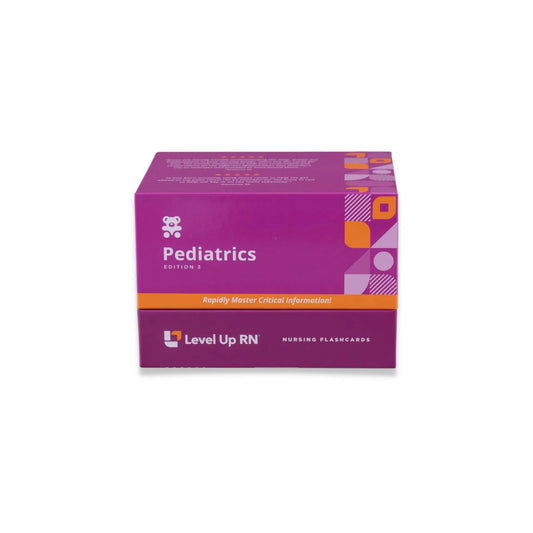Peds, part 28: Cardiovascular Disorders - Iron Deficient Anemia, Sickle Cell Anemia
Updated: Cathy ParkesIron-deficient anemia, including the pathophysiology, risk factors, signs/symptoms, labs, treatment, nursing care, and family teaching for this disorder. Sickle cell anemia, including the pathophysiology, risk factors, signs/symptoms, types of crises, diagnosis, treatment, nursing care, and family teaching for patients with this disorder.
Full Transcript: Peds, part 28: Cardiovascular Disorders - Iron Deficient Anemia, Sickle Cell Anemia
Full Transcript: Peds, part 28: Cardiovascular Disorders - Iron Deficient Anemia, Sickle Cell Anemia
Hi, I'm Cathy with Level Up RN. In this video, I will be talking about iron-deficient anemia as well as sickle cell anemia. If you have our Level Up RN Pediatric Nursing Flashcards, definitely pull those out and pay close attention to the bold red text on these cards because those are going to be particularly important facts for you to know. And at the end of this video, I'm going to give you guys a little quiz to test your understanding of some of the key points I'll be covering in this video, so definitely stay tuned for that.
First up, we have iron-deficient anemia, which is a decrease in hemoglobin due to insufficient iron intake or some kind of malabsorption syndrome that prevents the absorption of iron. So a key risk factor in young children is the excess intake of cow's milk. So if a kid is sucking down the cow's milk all day long, which is low in iron, then it's really filling them up, and they are less likely to eat foods which may be higher in iron. So signs and symptoms of iron-deficient anemia include fatigue, pallor, shortness of breath, as well as tachycardia. In terms of labs, we will see a decrease in the hemoglobin, hematocrit, red blood cells, MCH, MCV, and ferritin. Treatment of this condition would be done with iron supplementation, so this would be ferrous sulfate, which is the oral form of iron supplementation, or iron dextran, which would be administered through the IM or IV route. If we are administering iron supplementation via the IM route, we want to make sure we use the Z-track method in order to prevent leakage of the medication into the subcutaneous tissue.
In terms of family teaching, we want to encourage increased intake of iron-rich foods, which include green vegetables, meat, raisins, and iron-fortified foods. We also want to let the family know that vitamin C improves absorption of iron, and calcium-rich products will decrease absorption of iron. So we want our family to give the iron supplementation with orange juice and not with milk or antacids. We also want to let the family know that the child should use a straw and brush their teeth following administration in order to avoid stained teeth. This is if they're taking their iron supplementation in a liquid form. In addition, iron supplementation will cause green or black tarry stools, and this is an expected finding when we are giving an iron supplement, and it is not anything to worry about.
When a patient has sickle cell anemia, they will often experience crisises, and there are several crisises to be familiar with. Probably the most important one to know is called a vaso-occlusive crisis. So during this type of crisis, the patient will have severe pain that will need to be treated with opioid analgesics around the clock. They may also have swelling in their hands and feet during this type of crisis. Another type of crisis is a splenic sequestration crisis. So with this type of crisis, blood flow is blocked out of the spleen due to that sickling of the red blood cells, and this causes enlargement of the spleen. The patient may also exhibit hypovolemic shock. Then we have an aplastic crisis. So this is where we have severe anemia that is typically related to a viral infection. Then we have something called an acute chest syndrome, which is a type of crisis where blood flow to the lungs is impaired, so the patient will have dyspnea, fever, and cough. And then we have a hyperhemolytic crisis, which is characterized by a rapid decrease in hemoglobin levels.
In terms of diagnosis of sickle cell anemia, we can do what's called a sickle turbidity test, which will detect that abnormal hemoglobin, that HbS. We can also do something called a hemoglobin electrophoresis. In terms of treatment, we're going to give those opioid analgesics on a schedule. In addition, we need to provide antibiotics if there's an infection present. In addition, we will need to administer IV fluids to help decrease the viscosity of the blood because we're trying to help the flow of blood get to the organs, which will help prevent tissue hypoxia. And then we would give blood products and oxygen as ordered.
In terms of patient teaching, we're definitely going to want to encourage our patient to get enough fluid intake to help prevent dehydration and prevent the onset of a vaso-occlusive crisis. We also want them to avoid getting infection, so they need to perform meticulous hand hygiene and avoid crowds as well.
Now let's talk about sickle cell anemia, which is an autosomal recessive genetic disorder that causes chronic anemia, pain, infection, as well as organ damage. So the pathophysiology behind this disorder is that our normal hemoglobin, which is HbA, is replaced with abnormal sickle hemoglobin, which is HbS, and this causes sickling of the red blood cells. So normally, red blood cells are nice and round. When we have the sickling, they kind of turn into this C shape, and these red blood cells get easily caught in the blood vessels, which obstructs blood flow to the organs and can result in tissue hypoxia.
So in terms of risk factors associated with this condition, a family history is obviously going to be a risk factor because this is a genetic disorder. Also, African Americans and those of Middle Eastern descent are at higher risk for sickle cell anemia. Overall signs and symptoms include pain, fatigue, shortness of breath, pallor, as well as jaundice.
All right, it's time for a quiz. I've got three questions for you. First question, a toddler who drinks an excess amount of cow's milk is at risk for what disorder? The answer is iron-deficient anemia. Question number two, what increases and what decreases iron absorption? The answer is vitamin C increases iron absorption, and dairy products decrease iron absorption. Question number three, how should pain be treated for a patient with sickle cell anemia experiencing a vaso-occlusive crisis? The answer is their pain should be treated with opioid analgesics around the clock. All right, that's it for this video. Hope it was helpful. Take care and good luck with studying.
First up, we have iron-deficient anemia. This is where we have decreased hemoglobin due to insufficient iron intake or some kind of malabsorption disorder that prevents a-- [laughter] next.


